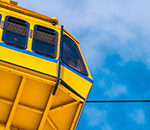Parkour combines physical strength and artful movements to overcome obstacles, such as walls, stairs, and fences. Urban landscapes are playgrounds for parkour artists, also known as traceurs. However, photographing the graceful feats of these artists amid tall buildings presents a challenge. The lighting and constricted space in city environs don’t always offer photographers the best of working conditions. Parkour photography requires adaptability.
Joe McNally shows off his versatility by going “light and fast” on the streets of Brooklyn, NY. His goal was to photograph Jonathan, a talented parkour artist, using just an unmodified Nikon SB 910 Speedlight in hard sunlight:
To set up the shot, McNally first looked around the location for inspiration. He wanted the subject to “pop”, so he chose a yellow wall. He asked Jonathan run up the wall so he was about five feet off the ground and had him look back toward the light. The photographer then decided on using a low camera angle to emphasize the athletic ability of his subject.
Normally, McNally says, it’s advisable to match your artificial light source’s direction with the direction of the natural light. Lights coming from different directions cast multiple shadows at varying angles, which can often ruin a shot. But, in this case, he risked the unnatural look of added shadows in order to have his assistant, holding a flash mounted on a painter’s pole with a Kacey Pole Adapter, hide in the shadow of a utility pole. This off-axis lighting setup created an extra, faint shadow of the subject, but kept the assistant’s shadow from appearing in the shot.
Attention to detail and industrious use of surroundings and equipment are crucial to parkour photography. McNally’s final shot highlighted the traceur’s impressive skills:
“…that’s the rule of location, really: break rules.”
Like This Article?
Don't Miss The Next One!
Join over 100,000 photographers of all experience levels who receive our free photography tips and articles to stay current:







Leave a Reply